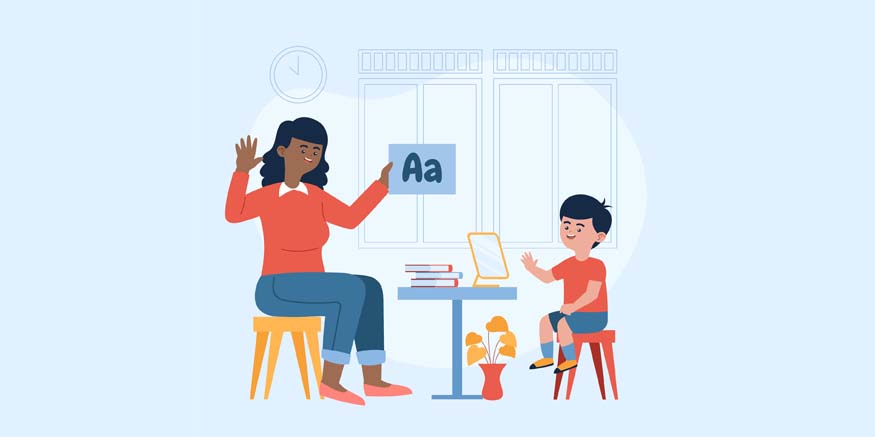The first five years of a child’s life are crucial for their learning, behaviour, and health. Experiences during early childhood help shape the brain and the ability to learn, build social skills, and handle everyday challenges. A child’s emotional, social, and physical growth directly impacts their behaviour, social skills, readiness for school, and overall development, affecting habits that can last into adulthood.
Different domains of child development
Every step of growth involves advancements in five different areas. These areas are connected, and a child cannot move forward in one without progressing in the others. Keep in mind that your child will develop at their speed!
- Communication domain
- Physical domain
- Social-emotional domain
- Cognitive domain
Children need to learn how to communicate well with their family, friends, teachers, and others. Communication is the first step in child development and will lead to better conversation skills and relationships as they get older.
During the 5 stages of child growth, the body improves both gross and fine motor skills. Fine motor skills help your child move with balance, coordination, ease, and confidence.
Children’s social and emotional growth is important for them to learn about themselves, their feelings, and how to communicate with others. Preschoolers’ emotional well-being helps them build good relationships and handle their emotions in different situations.
Children’s cognitive development encompasses their thinking, understanding, and interaction with the world. Key milestones in cognitive growth involve math and science concepts like quantity, classification, and cause and effect. The initial 5 years play a crucial role in shaping children’s learning approach. Cognitive progress also involves traits such as curiosity, seeking information independently, and adjusting behaviour based on new knowledge.
5 Child development stages
- Newborn (0-3Months)
- Infant (3-12 months)
- Toddler (1-3 years)
- Preschool (3-5 years)
- School age ( 5-17 years)
Newborns communicate mainly by crying, but they can also become calm when spoken to. They start cooing around two months old and making vowel sounds. They can turn towards sounds, follow objects with their eyes, grasp objects, and lift their head for longer periods. Newborns try to look at people and will start smiling at them. They are interested in familiar objects and people from a distance, and may even get bored with repeated activities.
Communication: Babies start babbling between 3-6 months. After this, they will imitate sounds and laugh between 6-9 months. By 9-12 months, they can imitate sounds, use gestures, and say a few simple words.
Physical: At 3-6 months, babies can control their head movements and bring their hands together. By 6-9 months, they can sit without support and bounce while standing. From 9-12 months, they can pick up objects, crawl, and stand without help.
Social-Emotional: Between 3-6 months, babies respond to facial expressions and different tones of voice. From 6-9 months, they respond to gestures like clapping and understand others emotions. They also start feeling comfortable with familiar faces and anxious around strangers. By 9-12 months, they express emotions, form connections, and build relationships.
Cognitive: From 3-6 months, babies recognize familiar faces, notice music, and respond to love and affection. Between 6-9 months, they develop receptive language skills, and understanding words. From 9-12 months, they imitate gestures, grasp the concept of “no,” and explore cause and effect by throwing objects.
Communication: Language skills expand greatly during your child’s toddler years. They will start with a few words and gradually build up to full sentences by the age of 3. Their communication skills will continuously improve during this time.
Physical: Children start using a preferred hand, reaching movement milestones, and gaining confidence in walking and feeding themselves starting at one year old. By the age of 3, they can dress and undress themselves, use the toilet alone, and play more actively.
Social-emotional: At one year old, children develop object permanence, and from 2 to 3 years, they experience a rollercoaster of emotions and begin to understand others’ feelings. This stage also marks the beginning of playing alongside other children and increased confidence with strangers.
Cognitive: At 1 year old, children can name body parts and recognize familiar objects in books. By 2 to 3 years, they can name colours and recognize shapes, showing significant cognitive development.
Communication: By the age of 3, your child will improve their speech, asking more questions and making fewer grammatical errors.
Physical: At 3 years old, your child’s motor skills are getting stronger every day, as seen clearly on the playground. They are more confident riding tricycles, climbing play structures, and catching balls. In the classroom, they are honing their fine motor abilities with scissors, writing, drawing, and using utensils.
Social-Emotional: At 3 years old, children become more comfortable around others, engaging in imaginative play and group games. They are learning to express themselves and understand their emotions and actions.
Cognitive: Your child’s memory improves, they can sing songs, tell stories, recognize numbers, and know their name and gender. They are better at focusing and starting to read independently.
Communication: Children at five years old start using more complex sentences, telling stories, answering questions, reciting nursery rhymes, and singing songs. Their language skills become more advanced as they grow.
Physical: At five years old, children are mostly independent in their fine motor abilities. They can dress, eat, and wash on their own.
Social-Emotional: Five-year-old children become more socially aware, having conversations, making new friends, having fewer arguments, taking turns, being bossy, and expressing anger through actions or words. They enjoy independence but still need comfort and reassurance. Their social environments and experiences shape them as they grow.
Cognitive: Starting at four years old, children have a stronger sense of right and wrong and can understand contextual words, comparisons, numbers, colours, sizes, and time with increased understanding. The complexity of various subjects increases as they grow.
Playing and practising are key for building the small muscles needed for fine motor skills. When you praise and encourage your child for their efforts, it helps them stay interested and builds their confidence. Mother’s Pet Kindergarten focuses on nurturing young minds, creating a great space for these values to grow while helping children improve their fine motor skills with a blend of traditional wisdom.













Recent Comments